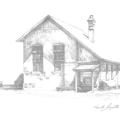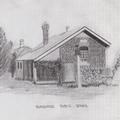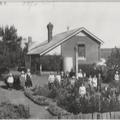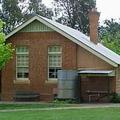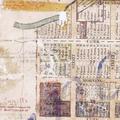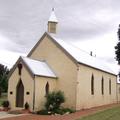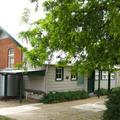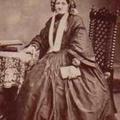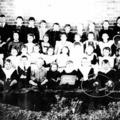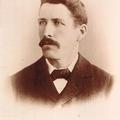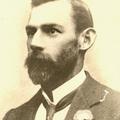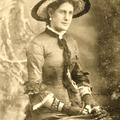< Early Canberra Government Schools
Gundaroo [1865 - 2015]
[Adapted from Lyall Gillespie: Early education and schools in the Canberra Region, 1999].
Gundaroo's first Public School opened in October 1865 with Hugh McPhee, a Scots Presbyterian, as teacher - but it had closed by the end of the year! Lea-Scarlett (1972) records that "The school Inspector had strong reservations about McPhee's competency and sobriety....but there was support for the school from the three denominations represented in the village and McPhee entered on his duties at a salary of ten shillings per week raised locally pending recognition of the school as a National School". The school was conducted in the newly built Presbyterian church, McPhee surviving by virtue of free lodging at the Royal Hotel, but no government aid forthcoming the school closed before the end of the year.
A new application for the establishment of a public school was submitted in March 1867 by a local committee comprising Joseph T.H.Styles, Arthur Affleck and William Affleck. The site proposed, for a stone building, was on the corner of Lot and Morning Streets.
The following parents - all claiming to reside within two miles of the proposed school - undertook to send a total of twenty-eight children to the school if one was opened:
Joseph T.A.Styles 4
Frederick Hoare 3
Thomas Booth 2
William McEnroe 3
John Hardwick 3
John Geary 3
Charles Derby 2
Edward Payten 1
Charles Walmsley 1
H. Bailey 2
Henry Quinn 1
Arthur Affleck 3
School Inspector Harris duly recommended that a Provisional School be established, but this did not happen. The residents persisted:
"Notices have been stuck up at all the public places, the stores, Royal Hotel, and post-office, calling a public meeting at the court house, Gundaroo, on Monday next at two p.m., for the purpose of trying to establish a public school at this place. I believe Mr. Massy has kindly offered the use of a building for the school if one should be opened, until the residents are able to get a building erected as a public school-house".
[Goulburn Herald and Chronicle, Wednesday 24 June 1868]
Following this public meeting, a further application was submitted in July 1868 over the names of Hugh Valance junior, Charles Massy, Arthur and William Affleck. Inspector McIntyre supported the application but suggested that a teacher not be appointed until the building was put into good repair.
This still produced no result, and a further application was made on 8th September 1868, this time proposing to raise £80 by local subscription towards the erection of a school, teacher's residence, outbuildings, and furniture at a total estimated cost of £240. This offer was evidently accepted for a cheque for £80 was sent later in the month, and the Council of Education's architect forwarded plans for the Gundaroo school and residence on 28 September 1868.
The local committee responded promptly. William Affleck notified the Council on 5 October 1868 that tenders had been called for the erection of the buildings. On 2 November Affleck forwarded the two tenders received, and the lower tender of £293 10s 0d from Thomas Jobson of Gunning was accepted. Meanwhile Charles Crew had been appointed teacher and begun teaching on 16 October 1868 in temporary premises. The local committee advised the Council in August 1869 that the work was almost completed.
The new school had barely been occupied and put to use when on 1 February 1870 William Affleck informed the Council that attendance had significantly declined, and expressed the via that until parents were compelled to send their children attendance was not likely to materially change. Inspector McIntyre recommended that Gundaroo school be worked on a half-time basis with the school at Gundaroo Upper, with Mr John Boate as teacher. This arrangement took effect in October 1870.
Joseph T.A.Styles wrote to the Council on 6 September 1870 protesting against the reduction of the schools to a half time basis. This protest was supported by a further letter from William Affleck, including the request that the Council establish Gundaroo full time again as a Provisional School, with Mr A.J.Slatterie as teacher. This was approved, and in June 1871 Gundaroo was further upgraded to public school status.
Slatterie departed in October 1872, leaving the school without a teacher until June 1873 when William Fursman took up duty. (Fursman's daughter Tryphenia was controversially appointed first teacher at nearby Mugwill school in 1875). Affleck wrote to the Council in May 1873 requesting an additional room be constructed for the residence, enclosing the only tender - from Mr J.Barrett; this was accepted. In 1898 a new school built my Messrs King and Armstrong was opened.
Gundaroo Public School celebrates its 150th Anniversary on 21 March 2015, and is still going strong. The history of the school is well told and illustrated in a special commemorative document produced for this anniversary.
Another more detailed history of the school can be found on Graeme Challinor's Gundaroo pages, along with a great deal more information about Gundaroo. His history of the school is extracted here, with grateful permission:
Gundaroo Public School
On 31 July 1865, an Application for the Establishment of a Non-Vested National School was completed by residents of Gundaroo. The application read:
"The undersigned being desirous to place under the supervision of the Board of National Education the school under our direction at Gundaroo ... hereby request that the Commissioners will be pleased to award a salary to the Master, and aid in Books ...".
The application was signed by Messrs Frederick Hoare, Thomas Booth and Arthur Affleck, all of Gundaroo. Twenty-eight pupils were expected to attend the school, paying sixpence per week each. It was planned to erect a school building 30 feet by 16 feet, of slabs, with hardwood floors and a bark roof, on land granted by the government for the building of a Presbyterian Church. The school building was to contain a schoolroom, a bedroom and a sitting room, thus functioning as both school and teacher's residence.
Mr Hugh McPhee, a 50 year old Scot, unmarried, was appointed first teacher by the local patrons, with a remuneration of 10 shillings per week. Mr McPhee had taught in the Queanbeyan district for the previous nine years.
Mr Inspector Harris commented on the application in a report dated 18 September 1865 to the Chief Inspector, Sydney. He stated that the school was already in operation in premises which are not described. There was already a Church of England school at Gundaroo, but this was not within three miles of the site of the proposed new school, so that there was no objection to the establishment of a public school at Gundaroo.
However,
"Considering that the schoolhouse is not erected, that only 15 children belong to the school, and that the teacher's qualifications are doubtful, I beg to submit that aid to be witheld until the completion of the building, an increase in the attendance, and the examination of the teacher."
These conclusions were passed on to the local patrons, who replied in a letter dated 25 October 1865, that they were anxious to retain Mr McPhee's services and had started a subscription list pending the new year when they hoped the Council would see fit to provide a salary.
Apparently this situation did not suit the teacher for he resigned at the end of 1865. There are no further records of the school until 1868.
On 1 July 1868 Messrs Arthur Affleck, Hugh Vallance, Charles Amatty and William Affleck as secretary of the local patrons' committee completed an Application for the Establishment of a Public School. They added, as a rider:
·- we guarantee the use of a stone house free of rent for three years, or the use of the Presbyterian Church till we obtain subscriptions for the erection of a public school.'
Twenty-eight (28) children of school age lived within two miles of the proposed school, and 41 within four miles. However, in regard to numbers much depended on the aftermath of the closing the previous day (30 June 1868) of the Church Of England school, due to the withdrawal of its certificate. (In fact a provisional school was set up in place of the church school in July 1868).
The Council of Education agreed to aid the Public School to be established at Gundaroo The local committee requested that the Council send books and equipment for the school to Sutton Forest where they would be picked up by Mr Vallance with horse and dray.
On 10 September 1868 the Council advised the local committee that they would appoint a teacher. In reply Mr Affleck wrote:
" ... if the teacher and family are forwarded to Marulan by train, ... (the local committee) will send down a horse and dray to convey them from Marulan to Gundaroo, but if they have any quantity of luggage it must remain at the station till a Gundaroo-team goes there.'
In addition a cheque for ₤80 was enclosed being the local subscription in aid of the proposed Public School.
The teacher, Mr Crew, and his wife arrived on 15 November 1868, Mrs Crew taught sewing.
In 1869 a site of one acre, three rods and 20 perches was dedicated for school purposes. In March of that year work began on the construction of new school buildings and a teacher's residence. The contractor Mr Thomas Jobson, had submitted a tender for the work for ₤239-10-0.
There was some delay in the building due to difficulty in obtaining bricks in the district and to heavy rains interfering with the quarrying of stone. The buildings were ready for occupation in September, 1869.
Parents' apathy towards their children's schooling was stressed in a letter written by the Secretary of the Local School Board to Council of Education in February 1870:
"If education was compulsory there might be an average daily attendance of about 40 instead of the present average."
The average attendance for the March quarter of 1870 was eleven, and for the June quarter nine. Consequently, Mr Inspector McIntyre recommended that one teacher should run both Gundaroo Public and Gundaroo Provisional as half-time schools, the former to be known as Gundaroo, the latter as Gundaroo Upper. Mr Crew was subsequently transferred, and Mr Boate, teacher of the original Provisional School at Gundaroo became, for a short period, teacher of "Half Time Schools Gundaroo".
However, records suggest that the former Public School was reopened in 1871 as Lower Gundaroo Provisional School under Mr Slatterie. Mr Boate reverted to being teacher of Upper Gundaroo Provisional School. (A year later, in January 1872, permission was granted for Upper Gundaroo Provisional and Sutton to be run as half-time schools by Mr Boate.)
The problem of small attendance apparently remained, for in February 1872 Mr Slatterie advised that attendance had been low at the beginning of the school year due to sickness, harvesting, bushfires and a flooded river.
Mr Slatterie left the school on 31 October 1872 and the school remained without a teacher until 19 May 1873, when Mr W. Fursman was appointed provisionally.
Probably the greatest obstacle to the advancement of the school was the low attendances. Children were often needed to help on the farm or were prevented from coming to school by floods. Even so. there were many who complained over the lack of interest in education by parents. One early teacher noted,
"Riding a horse and driving a team of bullocks is, in the opinion of a good many, all the education the young ones require."
To encourage the teacher to assist in the recruitment of pupils, it was decided at one stage to employ him without pay until attendances reached 15.
Occasionally, though, teachers were found to be lax. One teacher was in the habit of leaving the school in the charge of a senior pupil while he went off gold prospecting.
Eventually the original building fell into a very poor state of repair as well as becoming too small for the class. An inspector reported in 1897 that daily, due to the hot summer weather and the size of the class,
"the teacher is compelled to go out in the open air to recover sufficient strength and energy to proceed with his duties, while every child has to carry a bottle of drinking water to school owing to the bad state of the school tank water which really stinks and is a floating mass of insects."
A new building was opened in August 1898. In later years it was set off by extensive gardens of flowers and vegetables. However the old blue stone residence remained for many more years until eventually dismantled. The structure had been badly weakened by crumbling mortar, heavy rains and an earth tremor. In 1929 a teacher reported that a
'tornado swept into the township of Gundaroo unroofing several houses and doing considerable damage to school property...the girls' WC was blown literally to pieces and most of the front fence blown down...and the residence severely shaken."
Earlier in 1901, a teacher had complained to the Inspector of schools that
"the Sanitary Paper with which the walls of the Eastern front room of the teacher's residence here, are covered, is continually becoming detached at various places. causing the room to assume an untidy appearance, and affording harbour for vermin."
In 1969 the school was threatened with closure as only seven children were attending, Eventually three additional, rather young, children were found who brought the numbers over the required minimum of nine.
A significant increase in enrolments since then has seen the conversion of the school residence into an Office/Administration block in 1992 and the building of a new double classroom in 1993. By 1997 the school's enrolment had grown to 79 students and there were three teachers.
The school celebrated its 150th Anniversary in 2015, an event which attracted the interest of the Canberra Times
Gundaroo teacher's wife a prize winner
Mrs. Lowe, teacher of sewing at Micalago school a few days ago received a prize medal from the Chicago World's Fair. It is a bronze medal, in a silver case, with certificate. At the time she sent her work to the Exhibition Mrs. Lowe was at Gundaroo.
[Goulburn Evening Penny Post, 3 Dec 1896 p.4]
References
Eroll Lea-Scarlett, 'Gundaroo', Roebuck 1972 p.38 ff)
Location Map
Related Photos
Teachers
- McPhee, Mr Hugh
10/1865 - 12/1865 - Crew, Mr Charles
10/1868 - 10/1870 - Boate, Mr John Beresford
10/1870 - 01/1871 - Slatterie, Mr A.J.
01/1871 - 10/1872 - Fursman, Mr William
06/1873 - 04/1877 - White, Mr James Erskine Conwell
04/1877 - 08/1883 - Gordon, Mr Hector Murray
08/1883 - 01/1891 - Lowe, Mr James Francis
01/1891 - 07/1895 - McDonald, Mr Martin Livingstone 'Thomas'
07/1895 - 10/1907 - Lake, Mr Thomas A.
10/1907 - 02/1912 - Heazlett, Mr Rupert C.
HT - Williams Creek, 03/1908 - 05/1913 - Campbell, Mr Andrew
02/1912 - 03/1917 - Lake, Mr Herbert A.
03/1917 - 04/1926
School Website
NSW Government schools from 1848
- Gundaroo (external link)
< Early Canberra Government Schools
If you are able to assist our work of identifying, documenting, and celebrating the early bush schools of the Canberra region, please contact us or .



